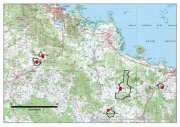NESP TWQ Round 5 - Project 5.9 – Gully Remediation Effectiveness
There is significant Government investment in water quality improvement focused on reducing gully erosion (~$50M), however, there is limited measured data to demonstrate the effectiveness of the remediation approaches. This project is collected land condition, terrain and water quality data from five gully remediation trial sites in the Burdekin catchment. The data demonstrated whether the on-ground investment programs are actually improving measured water quality, and quantified the cost-effectiveness of the various approaches. The measured field data was extrapolated using Lidar, supporting the prioritisation and evaluation of future remediation sites over larger (whole of property) scales. Communication products were developed to provide the evidence needed to increase landholder engagement in remediation programs that are focused on improving water quality runoff to the GBR.
This project is a continuation of NESP TWQ Round 2 - Project 2.1.4.
Images
Datasets

This dataset contains Vegetation and Biomass monitoring data collected for the NESP TWQ Project 5.9, formally NESP TWQ 2.1.4 - Demonstration and evaluation of gully remediation on downstream water quality and agricultural production in GBR rangelands and Landholders Driving Change (LDC) contracts LRP17-003 and LME17-009. Data is from control and treatment gully sites on commercial grazing properties in the Burdekin.
BOTANAL files describe the biomass, species composition and species attributes such as basal area and cover for hillslope areas above gully erosion sites.

Seven paired Control/Treatment gully sites on commercial grazing properties in the Burdekin are presented here as part of the monitoring project NESP TWQ Project 5.9 - Gully Remediation Effectiveness as an extension to the NESP TWQ Project 2.1.4 - Demonstration and evaluation of gully remediation on downstream water quality and agricultural production in GBR rangelands (Bartley et al., 2018).

Five paired Control/Treatment gully sites on commercial grazing properties in the Upper Burdekin and Bowen catchments are being monitored as part of NESP Project 2.1.4 (Demonstration and evaluation of gully remediation on downstream water quality and agricultural production in GBR rangelands) (Bartley et al., 2018).
The key question being asked is: "Is there measurable improvement in the erosion and water quality leaving remediated gully sites compared to sites left untreated?" The monitoring approach uses a modified BACI (Before after control impact) design.





